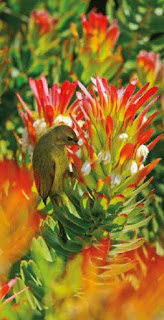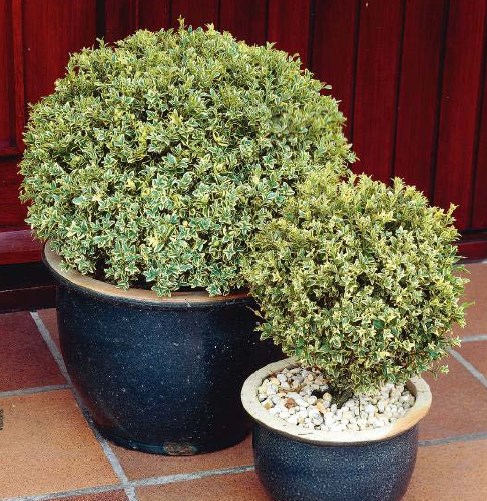 |
| Well-wooden gardens offer perching places for bird calling in for food or water Seed |
As the cold of winter bites and plant growth slows down, the natural food resources for birds diminish. This results in migration and temporary relocations for many of our feathered friends, which means there is always an influx of birds to gardens where artificial feeding and watering stations are kindly provided. Debate always rages on this subject, as to whether it is beneficial or detrimental to the birds in the long run.
 |
| Birds visiting an ornate feeding house |
Whatever the answer, gardeners continue to provide food and water for birds as the human population expands and diminishes the natural habitats of all forms of wildlife.
A little practical advice on feeding birds in the garden includes positioning feeders where the birds feel safe and comfortable. Also keep them off the ground if domestic pets are a threat. While birds would usually prefer to feed on the floor, this is not always possible. They need twiggy branches in dose proximity to alight upon during arrival and departure. Secluded and protected areas are usually preferred to exposed positions where birds of prey can strike.
There are different types of artificial bird feeders for the various diets that birds require. Seed is the most common and easiest form of garden bird feeding. Fruit, insect and nectar feeders are a little more specialized and required more care and attention than simply scattering some seed or grain in the garden.
 |
| Sunbirds flock to flowering aloes, especially during the lean winter months |
Seed
Seed-eaters (doves, sparrows, canaries, weavers, manikins, widowbirds, bishops, whydahs, waxbills, firefinches).
These birds visit garden frequently and readily to feed on the different seeds and grains placed in bird feeders or simply sprinkled on the ground.
Large seeds like sunflowers attract thick-billed weavers to the garden, while smaller seed attract a wide variety of smaller birds. Large birds like doves and flocks of weavers oftenchase the smaller species away by simply dominating the feeding territory. The smaller birds therefore often prefer to use smaller feeders that only allow one or two small birds to alight upon the feeding perches at a time. This prevents the larger types from sing the feeding station, and gives the manikins, waxbills and firefinches the chance to feed in peace.
Growing grass seed in a meadow-type planting also assist an attractive habitat for seed eaters, although this may entail sacrificing part of the manicured lawn areas that tend to
be somewhat sterile from a bird’s perspective. The winter annual grass (Poa annua) that
is often viewed as a weed always attract the smaller bird species to the ample seeds that
set the cooler months.
 Fruit
Fruit –eaters (bulbuls, mousebirds, barbets)
Fruit
Fruit –eaters (bulbuls, mousebirds, barbets)
Fruit feeder are generally simple metal spikes attached to wooden logs or more sophisticated structures in the garden. Fresh fruit like apples, bananas, pears, and orangesegments are skewered onto the spike. Birds feed on the fresh fruit, but usually ignoreolder fruit that has started to shrivel or ferment, so fresh food needs to be set out on a daily basis. Garden that a frequented by monkeys have the fruit pilfered by these scavenging mammals, chasing the birds away.
Fruit and berry-producing plants attract these birds to the garden. However, many exotic plants are spread far and wide by birds that have eaten their fruit, leading to their classification as alien invader species. Be aware of this fact when planting fruiting plants.
 |
| Birds visit winter flowering shrubs for nectar |
Insect and Nectar
Insect-eaters (thrushes, chats, rock thrushes, robin chat)
Artificial feeders filled with sugar supplement attract birds that feed on nectar. Due care needs to be taken in preparing the ‘sugar water’ and the subject needs to be thoroughly researched to use these feeders effectively.
Certain plants that bloom in winter with nectar rich flower are important for supporting bird life during this time of famine. Aloes are the most significant group of plants in the local garden environment during winter, providing nectar and food to numerous birds including see, fruit, and insect-eater. Often starling, orioles, rock thrushes and weavers are seen feeding on aloe flowers.
 |
| Ornate fountains can also serve as practical | | | | |
|
Water
Water in the garden
In the summer-rainfall regions a regularly supply of fresh, potable water is vital for garden bird life. Often more birds can be seen at the watering points than at feeding
stations. Fill them up with clean water regularly, almost on a daily basis, and the birds
will reward you with their undivided support. There are numerous bird baths, waterbasins an ponds that fit the bill. Flowing water and artificial water features also serve a practical purpose in supplying drinking water to our feathered friends.
Give thought to lesser life forms during the winter months and provide food, water and shelter for them until spring returns with its bounty.
 |
| A rustic bird feeder hangs as a feature from a tree branch |
 |
| Metal spikes secure fruit o a large log that also sports seeds and grains to attract a wide range of bird. |
 |
| This wood and Perspex feeder keeps the seed dry, dispensing food as it is consumed to reduce wastage. |
 |
| An attractive metal bird feeder. You can use old plough for this purpose. |
 |
| A supply of water is just as important as food |
 |
| Black-collared barbets visit fruit feeders during winter. |
 |
| Rhamnus prinoides produces masses of berries that are feasted upon by fruit-eaters |
 |
| Additional ornamentation adorns a fruit feeder |
 |
| A dark-capped bulbul feeding on a banana placed on a metal spike in the garden |
 |
| A cape white-eye at a nectar dispenser |
 |
| Weavers on an Aloe ferox |
 |
| A nectar feeder hangs in a likely spot. |
 |
| Traditional rock grindstones make perfect, natural bird baths. |
 |
| A bird bath in a shaded secluded setting |






































